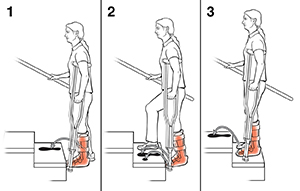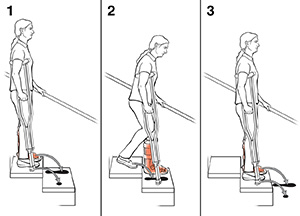Using Crutches: Up and Down Steps
When climbing up and down steps, remember this rule: Up with the good (unaffected leg) and down with the bad (affected leg). Note: If you’re supposed to keep all weight off your leg (non-weight-bearing), ask your healthcare provider for special instructions.
Tip: Ask a friend to carry 1 of your crutches while you go up or down stairs.
Take care when using stairs
-
Always use an elevator if available.
-
Have someone guard you as you learn to use stairs. A guard stands below you. They hold your belt (or a special “gait belt” you can borrow or buy) to help you if you lose your balance.
-
When there is no handrail, keep 1 crutch under each arm. Follow the instructions above.
-
If the stairs are slippery or steep, it may be safer to lift or lower yourself from step to step while sitting. Hold both your crutches in 1 hand as you do so.
Up stairs
-
Hold the handrail with 1 hand.
-
If a friend is not available to carry 1 of the crutches, put both crutches in your other hand.
-
Support your weight evenly between the handrail and your crutches.
-
Put some weight on the crutches.
-
Step up with your unaffected foot.
-
Get your balance.
-
Straighten your unaffected knee and lift your body weight.
-
Bring your crutches and affected leg up.

Down stairs
-
Hold the handrail with 1 hand.
-
If a friend is not available to carry 1 of the crutches, put both crutches in your other hand.
-
Bend your unaffected knee, moving your crutches and affected leg down.
-
Support your weight evenly between the handrail and your crutches.
-
Slowly bring your unaffected leg down.
-
Don’t hop.

© 2000-2024 The StayWell Company, LLC. All rights reserved. This information is not intended as a substitute for professional medical care. Always follow your healthcare professional's instructions.